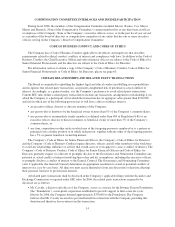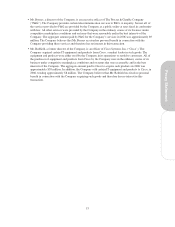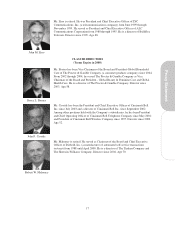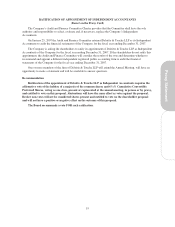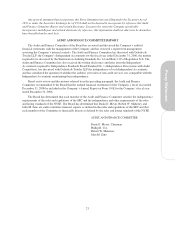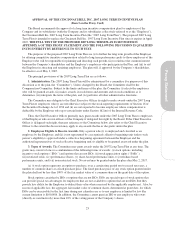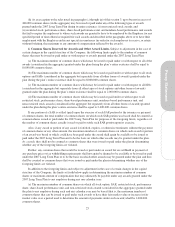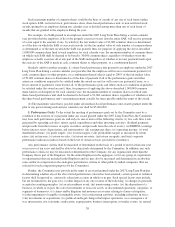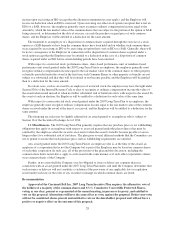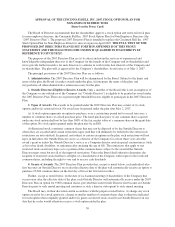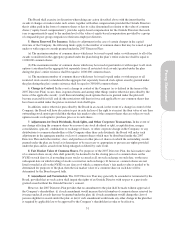Cincinnati Bell 2006 Annual Report Download - page 35
Download and view the complete annual report
Please find page 35 of the 2006 Cincinnati Bell annual report below. You can navigate through the pages in the report by either clicking on the pages listed below, or by using the keyword search tool below to find specific information within the annual report.
APPROVAL OF THE CINCINNATI BELL INC. 2007 LONG TERM INCENTIVE PLAN
(Item 3 on the Proxy Card)
The Board recommends the approval of a long term incentive compensation plan for employees of the
Company and its subsidiaries (with the Company and its subsidiaries collectively referred to as the “Employer”),
the Cincinnati Bell Inc. 2007 Long Term Incentive Plan (the “2007 Long Term Plan”). The proposed 2007 Long
Term Plan is intended to replace the Cincinnati Bell Inc. 1997 Long Term Incentive Plan since it expires in April
2007. THE FULL TEXT OF THE PROPOSED 2007 LONG TERM PLAN IS SET FORTH IN
APPENDIX A OF THIS PROXY STATEMENT AND THE FOLLOWING DISCUSSION IS QUALIFIED
IN ITS ENTIRETY BY REFERENCE TO SUCH TEXT.
The purposes of the proposed 2007 Long Term Plan are (i) to further the long term growth of the Employer
by offering competitive incentive compensation related to long term performance goals to those employees of the
Employer who will be responsible for planning and directing such growth, (ii) to reinforce the common interest
between the Company’s shareholders and the Employer’s employees who participate in the Plan, and (iii) to aid
the Employer in attracting and retaining employees. The plan will, if approved by the Company’s shareholders,
be effective as of May 3, 2007.
The principal provisions of the 2007 Long Term Plan are as follows.
1. Administration. The 2007 Long Term Plan will be administered by a committee (for purposes of this
discussion as to the plan, the “Committee”). Unless changed by the Board, the Committee shall be the
Compensation Committee. Subject to the limits and terms of the plan, the Committee (i) selects the employees
who will be granted awards, (ii) makes awards, in such forms and amounts and on such conditions as it
determines, (iii) interprets the terms of the plan, and (iv) performs all other administrative functions.
The Committee may delegate to the Chief Executive Officer its right to make awards under the 2007 Long
Term Plan to employees who (i) are not otherwise subject to the stock reporting requirements of Section 16 of
the Securities Exchange Act of 1934 and (ii) are not expected to become employees whose compensation is
deductible by the Employer only up to certain limits under Section 162(m) of the Internal Revenue Code.
Thus, the Chief Executive Officer generally may grant awards under the 2007 Long Term Plan to employees
of the Employer who are not officers of the Company if delegated this right by the Board. If the Chief Executive
Officer is delegated such right, then any reference to the Committee below also refers to the Chief Executive
Officer to the extent the discussion may apply to any awards that he or she grants under the plan.
2. Employees Eligible to Receive Awards. Only a person who (i) is employed and classified as an
employee by the Employer; and (ii) is not represented by a recognized collective bargaining unit (unless such
person’s eligibility is approved under a collective bargaining agreement between the Employer and the
authorized representatives of such collective bargaining unit) is eligible to be granted an award under the plan.
3. Types of Awards. The Committee may grant awards under the 2007 Long Term Plan at any time. The
grants may consist of one or a combination of the following forms of awards: (i) stock options, including
incentive stock options (“ISOs”) and options that are not ISOs, (ii) stock appreciation rights (“SARs”),
(iii) restricted stock, (iv) performance shares, (v) share-based performance units, (vi) nonshare-based
performance units, and (vii) non-restricted stock. No award may be granted under the plan after May 2, 2017.
(a) A stock option represents an option to purchase, over a certain time period not to exceed ten years, a
number of common shares at a fixed purchase price. The fixed purchase price of any stock option granted under
the plan shall not be less than 100% of the fair market value of a common share on the grant date of the option.
Stock options can either be ISOs or options that are not ISOs. ISOs are special types of stock options that
can provide special tax advantages for employees that are not available to options that are not ISOs (but they
provide less ability for the Employer to deduct their value when exercised by the applicable employees). Also, by
reason of applicable law, the aggregate fair market value of common shares, determined at grant date, for which
ISOs can be exercisable for the first time during any calendar year as to any employee is limited by law (the
current limitation is $100,000). In addition, the Committee cannot grant an ISO to any employee who owns
(directly or constructively) more than 10% of the voting power of the Company’s shares.
23
Proxy Statement



